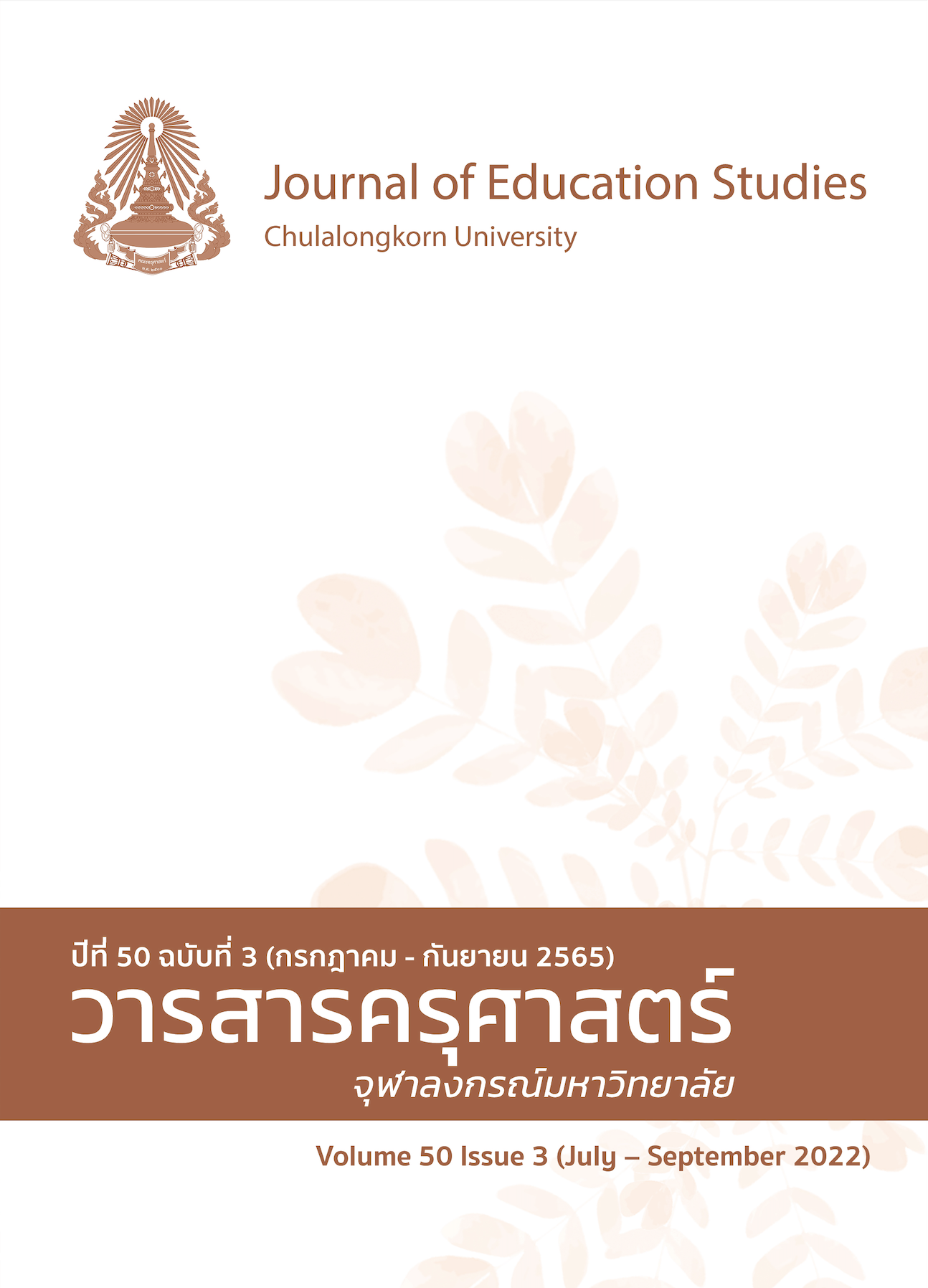การตรวจสอบคุณสมบัติทางจิตมิติของรูบริกสำหรับการประเมินทักษะดนตรีไทย: การประยุกต์ใช้โมเดลการให้คะแนนบางส่วนแบบหลายองค์ประกอบของราสช์
DOI:
https://doi.org/10.14456/educu.2022.22คำสำคัญ:
การตรวจสอบคุณสมบัติทางจิตมิติ, รูบริก, การประเมินทักษะดนตรีไทย, โมเดลการให้คะแนนบางส่วนแบบหลายองค์ประกอบของราสช์บทคัดย่อ
การวิจัยครั้งนี้มีวัตถุประสงค์เพื่อตรวจสอบคุณสมบัติทางจิตมิติของรูบริกสำหรับการประเมินทักษะดนตรีไทยโดยใช้โมเดลการให้คะแนนบางส่วนแบบหลายองค์ประกอบของราสช์ ตัวอย่างวิจัย คือ 1) นักเรียนระดับชั้นมัธยมศึกษาที่บรรเลงเดี่ยวเครื่องดนตรีไทยประเภทเครื่องตี 4 ชนิด ประกอบด้วย ระนาดเอก ระนาดทุ้ม ฆ้องวงใหญ่ และฆ้องวงเล็ก จำนวน 84 คน และ 2) ผู้ประเมินทักษะดนตรีไทยที่มีความเชี่ยวชาญและผ่านการอบรม จำนวน 6 ท่าน เครื่องมือวิจัย คือ รูบริกสำหรับการประเมินทักษะดนตรีไทย ประกอบด้วยเกณฑ์ 8 ด้าน 12 ข้อรายการประเมิน โดยแต่ละข้อรายการประเมินจะประกอบไปด้วยระดับคุณภาพ 5 ระดับ วิเคราะห์คุณสมบัติทางจิตมิติโดยใช้โมเดลการให้คะแนนบางส่วนแบบหลายองค์ประกอบของราสช์ผ่านฟาเซตที่เกี่ยวข้อง 4 ฟาเซต ประกอบด้วย ฟาเซตนักเรียน ฟาเซตผู้ประเมิน ฟาเซตเครื่องดนตรี และฟาเซตข้อรายการประเมิน ผลการวิจัยพบว่า 1) ผลความสอดคล้องกลมกลืนกับโมเดลของฟาเซตทั้ง 4 ฟาเซต ดัชนีคุณภาพฟาเซตผู้ประเมินและข้อรายการประเมิน ค่า point-measure correlation ของฟาเซตข้อรายการประเมิน และดัชนีประสิทธิผลระดับคุณภาพ แสดงถึงความตรงเชิงโครงสร้างของรูบริก และ 2) ผล Chi-square ฟาเซตนักเรียนและผู้ประเมิน และดัชนีคุณภาพฟาเซตนักเรียน แสดงถึงความเที่ยงของรูบริก
เอกสารอ้างอิง
ภาษาไทย
กมลวรรณ ตังธนกานนท์. (2563). การวัดและประเมินทักษะการปฏิบัติ (พิมพ์ครั้งที่ 3). สำนักพิมพ์จุฬาลงกรณ์มหาวิทยาลัย.
ชยพร ไชยสิทธิ์, มนัส วัฒนไชยยศ, และ บรรจง ชลวิโรจน์. (2560). การพัฒนาชุดฝึกระนาดทุ้มเพลงสาธุการของนักเรียน
ชั้นมัธยมศึกษาปีที่ 4 สาขาวิชาชีพปี่พาทย์ วิทยาลัยนาฏศิลปนครศรีธรรมราช สถาบันบัณฑิตพัฒนศิลป์. วารสารวิทยาลัยนครราชสีมา, 11(3),
-212.
รณฤทธิ์ ไหมทอง. (2564). การประพันธ์เดี่ยวระนาดเอกเพลงเทวาประสิทธิ์ สองชั้น เพื่อการประกวดเดี่ยวเครื่องดนตรีไทยระดับชาติ สำหรับ
นักเรียนระดับชั้นประถมศึกษา. วารสารวิชาการ คณะมนุษยศาสตร์และสังคมศาสตร์ มหาวิทยาลัยราชภัฏพระนคร, 5(2), 109 – 130.
ศิริชัย กาญจนวาสี. (2563). ทฤษฎีการทดสอบแนวใหม่ (พิมพ์ครั้งที่ 5). สำนักพิมพ์จุฬาลงกรณ์มหาวิทยาลัย.
สงบศึก ธรรมวิหาร. (2540). ดุริยางค์ไทย. สำนักพิมพ์จุฬาลงกรณ์มหาวิทยาลัย.
สำนักทบวงมหาวิทยาลัย. (2544). เกณฑ์มาตรฐานดนตรีไทยและเกณฑ์การประเมิน. ภาพพิมพ์.
ภาษาอังกฤษ
American Educational Research Association, American Psychological Association & National Council on Measurement in
Education. (2014). Standards for educational and psychological testing. American Educational Research Association.
Chen, W. H., Lenderking, W., Jin, Y., Wyrwich, K. W., Gelhorn, H., & Revicki, D. A. (2014). Is Rasch model analysis applicable
in small sample size pilot studies for assessing item characteristics? An example using PROMIS pain behavior item
bank data. Quality of Life Research, 23(2), 485-493. DOI: 10.1007/s11136-013-0487-5
DeLuca, C., & Bolden, B. (2014). Music performance assessment: Exploring three approaches for quality rubric
construction. Music Educators Journal, 101(1), 70-76.
Eckes, T. (2009). Introduction to many-facet Rasch measurement. Peter Lang Edition.
Edwards, A. S., Edwards, K. E., & Wesolowski, B. C. (2019). The psychometric evaluation of a wind band performance rubric
using the Multifaceted Rasch Partial Credit Measurement Model. Research Studies in Music Education, 1-25.
Engelhard, G. (1997). Constructing rater and task banks for performance assessments. Journal of Outcome Measurement,
(1), 19-33.
Fisher, W. (1992). Reliability, separation, strata statistics. Rasch Measurement Transections, 6(3), 238.
Krishnan, S., & Idris, N. (2018). Using partial credit model to improve the quality of an instrument. International Journal of
Evaluation and Research in Education, 7(4), 313-316.
Linacre, J. M. (1994). Sample size and item calibration stability. Rasch Measurement Transactions,
(4), 328.
Linacre, J. M. (1997, August). Judging plans and facets. https://www.rasch.org/rn3.htm
Linacre, J. M. (2002). Understanding Rasch measurement: Optimizing rating scale category effectiveness. Journal of
Applied Measurement, 3(1), 85-106.
Linacre, J. M. (2010). When to stop removing Items and persons in Rasch misfit analysis. Rasch measurement
transactions, 23(4).
Linacre, J. M. (2022a). A user guide to FACETS (Version 3.84.0) [Computer software]. https://www.winsteps.com/a/Facets-
Manual.pdf
Linacre, J. M. (2022b). A user guide to WINSTEPS (Version 5.2.3) [Computer software].
https://www.winsteps.com/a/Winsteps-Manual.pdf
Mohaffyza, M., Sulaiman, N., Lai, C. S., & Salleh, K. M. (2015). Measuring the validity and reliability of research
instruments. Procedia – Social and Behavioral Sciences, 204, 164-171. https://doi.org/10.1016/j.sbspro.2015.08.129
Uto, M. (2021). Accuracy of performance-test linking based on a many-facet Rasch model. Behavior Research Methods,
(4). 1440-1454.
Wright, B. D., & Masters, G. N. (2002). Number of person or item strata. Rasch Measurement Transaction,
(3), 888.
ดาวน์โหลด
เผยแพร่แล้ว
รูปแบบการอ้างอิง
ฉบับ
ประเภทบทความ
สัญญาอนุญาต

อนุญาตภายใต้เงื่อนไข Creative Commons Attribution-NonCommercial-NoDerivatives 4.0 International License.




